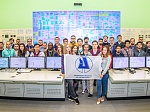05.06.2019
INFORMATION AND PUBLIC RELATIONS DEPARTMENT OF LENINGRAD NPP
Young scientists from 11 countries taking part in the ‘TEAM-2019’ conference held by Rosatom are visiting the new Leningrad NPP power blocks
In the context of the ‘TEAM-2019’, an international research and development conference for young scientists and nuclear power specialists, a group of participants from 11 countries visited the Leningrad NPP.
Both Russian and foreign guests familiarized themselves with the training process and the technical equipment within the Training Department of the innovative VVER-1200 power blocks at the Leningrad NPP as well as visited a VVER-1200 power block under construction.
‘We have been hosting such R&D conferences for young scientists and nuclear power specialists for 8 years, but this is the first time we got on an international level’, Maria Kirillova, a design engineer at the AO ‘Atomproyekt’ and a coordinator of the ‘International cooperation’ department, said. ‘As a result, we have received tons of applications from those willing to present their reports at our event and visit one of the Russian nuclear power plants. We came to the Leningrad NPP since we see it as the brightest and the best one we could show to our guest. By visiting it, they could see how well-advanced the Russian NPPs are’.
It was the first visit to the Leningrad NPP for the foreign guests, which is why the trip started with a stop at the Training Department where the whole algorithm of how the staff is supposed to work in different situation is practiced at a full-scale simulator. The visitors could witness how this process works.
Ahmed Farsim, student at the National Research Nuclear University MEPhI (Bangladesh): ‘My major is in theoretical and experimental physics of nuclear reactor. When I complete my studies in Moscow, I intend to return to Bangladesh where new NPP power blocks are constructed in close partnership with Rosatom. Having strong fundamental background in this area, I want to bring value to my country by working at nuclear facilities’.
Tarek Elzayat, student at the National Research Nuclear University MEPhI (Egypt): ‘I’m doing postgraduate studies, and I’m defending my thesis in two weeks, which is why I’m so grateful for an opportunity to visit the Leningrad NPP. Here, I got to witness the power blocks that will soon be in Egypt, my native country, too. I’m not yet decided as to whether I go for theoretical nuclear power or for working at an NPP, I was extremely excited to learn about the design specifics of VVER-1200 power blocks. This one differs from its predecessors considerably both in terms of advanced technical and economic parameters and in terms of its top-notch security standards. This is why many countries opt for it’.
The technical tours for the ‘TEAM-2019’ conference participants also encompassed visits to other companies in Saint Petersburg and the Leningrad Region – RosRAO, the Baltic Plant, the Petersburg Nuclear Physics Institute, the Virtual NPP power block.
Young scientists from the Leningrad NPP took part in the three-days conference, too. Dmitry Rozideev, the lead engineer at the metal fault detection and technical control, became the winner in the ‘Power Facility’ section. ‘The conference was very well-organized. The guys from the AO ‘Atomproyekt’ youth society did a fantastic job, the reports from the participants were great or even outstanding. The atmosphere was friendly, positive, and favourable’, Dmitry noted.
The Leningrad NPP is the country’s first plant with RBMK-1000 reactors (uranium-graphite circuit-type reactor running on thermal neutrons). The decision that marked its construction was taken in September 1966 by a resolution of the Central Committee of the Communist Party of the USSR and the Council of Ministers No. 800-252. According to that document, the Leningrad NPP was supposed to become a core in a network of nuclear power plants with RBMK-1000 reactors that were supposed to produce a substantial share of electric power. The construction of the Leningrad NPP was going well, and by 1973 the first power block was fully erected. On December 23, 1973, following stable 72-hours’ operation at the capacity of 150 megawatt, the State Commission signed the acceptance certificate stating that the first power block of the Leningrad nuclear power plant is commissioned for pilot production.



 career
career Innovations
Innovations Projects
Projects INTERNATIONAL BUSINESS
INTERNATIONAL BUSINESS